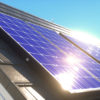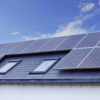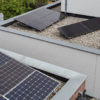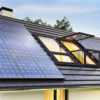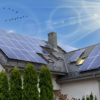Anyone who has wanted to buy solar panels has wondered this at some point or another. A nice sunlit sky won’t be there all the time. In fact, more often than not, it’s going to be at least a little cloudy.
Since a solar panel’s output rating is given against perfect conditions, just how much electricity can you realistically expect from your solar power system over the span of, say, an year?
This is a particularly tough question to answer since it depends entirely on how much sunlight your roof receives, and the peculiarities of weather in your area.
Even so, poor weather conditions do need to be taken into account while designing a solar power system. Here’s all you need to know about solar panel efficiency in bad weather.
What Does Rated Power Output on Solar Panels Even Mean?
Let’s start from the start. Whatever loss you’re going to experience when the sun’s not at its best will be against a solar panel’s rated power output which is given in watts. This is a number that’s given on a sticker on each solar panel.
Usually, solar panels come in ratings of 250 to 400 Watts. So, if you have a 400 watt panel, and if sunlight is falling at a 90 degree angle on the panels, then you can expect 400 watts of electricity per hour.
While there are a bunch of different ways to ascertain whether a solar panel is performing as expected, certification standards set by the International Electrotechnical Commission (IEC) are the most recognized.
The IEC has a range of certifications to test whether solar panels can perform under tough conditions. The IEC 61853 certification is specifically designed to test a solar panel’s power output against different irradiances. Called the “Photovoltaic Performance Testing and Energy Rating,” the test consists of three parts:
- IEC 61853-1: Tests a solar panel’s output performance against different irradiance and temperature parameters.
- IEC 61853-2: Tests changes in a solar panel’s spectral response and operating temperature at different angles due to irradiance, ambient temperature and wind speed.
- IEC 61853-3: Tests the solar panel’s energy rating, and describes calculations for PV module energy (watt-hours) ratings.
Aside from 61853, the IEC also has the 61215 certification standards that include power output and electric circuitry testing methods.
So, if your panel manufacturer claims they have either of these certifications, then you can safely assume their products will perform well, even in adverse conditions.
Cloudy With a Chance for Power Loss
So, we’ve established that solar panel output will decline but the rate of loss is established through testing standards. It’s not possible to go deeper into the many dimensions of how this rate is established without overshooting the scope of this article.
There are a few factors that come into play during cloudy days. Firstly, even when the sky is overcast, there is light, which is enough to help your solar panels generate electricity.
How much power depends entirely on how thick the cloud-bank is and if sunlight is seeping through on some occasions. Even under the most overcast conditions, solar panels will still produce 10% to 25% of their rated output.
The bit about how much sunlight seeps through the clouds is important as it can actually make up for power loss due to cloudy weather. The “edge of cloud” effect as it’s called results in sunlight refracting around the edges of clouds causing them to focus on to the ground.
This results in more sunlight hitting your panels, which in turn produce more electricity. So, whatever power you lose when the sun’s behind the clouds, your panels may catch up as the sun is emerging from them.
Fortunately, most of Australia has a very sunny climate year round. So, power loss that does happen due to cloudy weather will be negligible at worst. It’s also worth noting that good solar installers take average weather conditions into account when designing your solar power system.
So, if you live in an area like Melbourne, which can be very cloudy during certain times of the year, then a quality installer will offer you a choice for more solar panels to make up for any losses that can be expected during the time.
Should You Be Worried About the Weather?
Short answer is — No, because there’s no reason to. Solar panels are designed to produce maximum power under any conditions. A good installer will also set up the panels in a way that ensures they offer the highest possible output.
This is the reason why designing a system scientifically is so important.
As we stated before, how solar panels will perform on your roof is a highly subjective and depends on a lot of factors like irradiance, average weather patterns and your property structure. At bidmysolar™ we use one of the most advanced solar CAD suites in the world to design your system and to estimate how much solar potential your property has.
Our Advanced System Design suite uses the most up-to-date tools to create a solar power system that is best suited for your requirements! Feel free to contact us if you have any questions or would like to know more.

